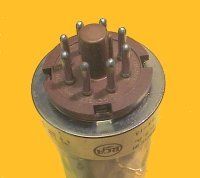
VR101
|
|
|||||||||||||||||||||||||||||||||
|
Entradas: 2983 Réplicas: 7
VR101 (VR101)
|
|
|
John Turrill
04.Jun.06 |
1
Dear Radio Friends, |
|
Jeremy Harmer
04.Jun.06 |
2
One other bit of information in the EVS sheet for this valve is "Diode 1 shall be the diode remote fromthe triode section" - but no indication as to why. I guess diode 1 has different characteristics due to its different proximity to the other electrode structures. Jeremy. |
|
Hans-Thomas Schmidt
04.Jun.06 |
3
Hi John, I dont have some characteristics to the VR101/CV1001. But I have short datas from the MHLD6: MOV, amplifier triode withs two diodes. common cathode. Octal: shield, f, p, diode1, diode2, nc., f, c. Cap = grid filament: 6,3V and 0,65 mA plate: 200V and 3,8 mA Grid: -3V Ra: 18200 Ohms gm: 2,2 mA/V amplification factor: 40 cathode resistance: 800 Ohms From the diodes there are no datas listed. Source: Babani, International radio tube encyclopedia, last edition 1958, 1. supplement Best regards, Hans-Thomas |
|
John Turrill
04.Jun.06 |
4
Dear Hans-Thomas, many thanks for your help, in actual fact, I should have mentioned I had seen the data in the Babani book, but the figures don't seem to make sense! I know the figures I quoted to be correct,- that is, 200v. on the anode with -5v. bias gives 11.5mA anode current & 3mA/v. - as this is from an official R.A.F. data sheet; sounds like the same one Jeremy has, and thanks for that also Jeremy. (if you've looked down inside the valve - difficult!-, you can just see the 1st. diode, with the second, smaller one just below that). As if to prove a point, testing a new valve at -3v. bias yields an anode current of about 25mA, so I have to assume Babani isn't correct (unusually). I've searched the web and all the books I can find, but I'm beginning to wonder if there is any further information! Thanks, John. |
|
Hans-Thomas Schmidt
04.Jun.06 |
5
Hello John, here are another datas from the MHLD6 from Osram: Triode, duodiode Octal: nc., f, d1, d2, p, nc., f, k filament: 6,3 V and 0,65 mA plate: 250 V and 11,5 mA gm: 3 mA/V from Prehled Elektronek, 1954 ------------------------------- VR101 = MHLD6 octal same like in my first post triode-duodiode f: 6,3 V and 0,65 mA p: 200 V and 11 mA g: -5 V from Röhrencodex 1951 Best regards, Hans-Thomas |
|
John Turrill
04.Jun.06 |
6
Dear Hans-Thomas, thanks again for this information, which seems to confirm all my previous data, and that, in this, the Babani is surely wrong. I find this a little worrying,- makes you wonder if any other data is wrong, too, in those books - though mostly you can cross-check with other sources, so far I've not found any other doubtful figures. As you mention Osram, am I right in thinking this is an original German firm? - and if so, I'm wondering how and in what way they came to be associated with the British Marconi firm? Regards, John. |
|
Hans-Thomas Schmidt
05.Jun.06 |
7
Hi John, the blue Babani book is one of the best I had ever seen. But it is very difficult to get them. My issue I have found it in Canada and it was not cheap. I have seen it firstly in the library of the Deutsches Museum in munich and it is a must for tube collectors. The Osram was a light bulb manufacture leaded by Siemens. At beginning of the last century they produced bulbs in several countries, so eg. in England. Osram started at 1906. The name is a abbreviation from Osmium and Wolfram (tungsten), two important metals for bulb manufacturing. In WWI the british Osram was occupied and they start to produce early tubes. Best regards, Hans-Thomas |
|
John Turrill
06.Jun.06 |
8
Dear Hans-Thomas, |
Fin de las contribuciones al foro de válvula
| Cumplimiento de datos | Más información |



